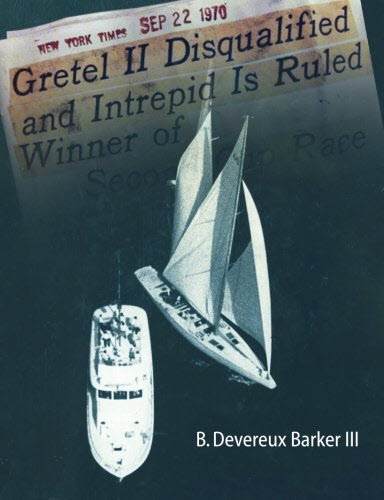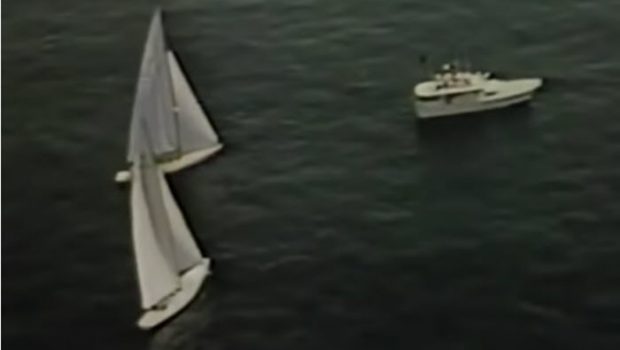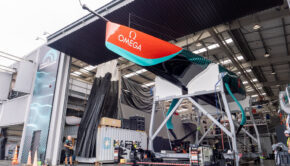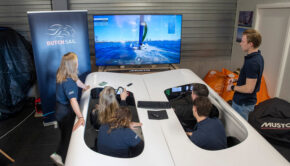A Not So Perfect Start
Published on August 20th, 2020
 by Peter Wilson
by Peter Wilson
It has been 50 years since Intrepid was victorious over Gretel II in the 1970 America’s Cup, and B. Devereux Barker, who was Chairman of the New York Yacht Club Race Committee that year, has written an excellent book; “Gretel II Disqualified, the untold inside story of a famous America’s Cup incident”.
His recounting is both accurate and insightful, and John Hopf’s pictures from a small airplane quite clearly capture the starting incident ‘heard round the world’. With all the wonderful stories of great starts by Scuttlebutt readers, this seems like an appropriate time to share a perspective from on board Intrepid.
Early during the long tow out of Newport to the America’s Cup buoy to try and complete the second race of the match, my very good friend and tactician Steve Van Dyck was stung by a bee who was unknowingly sharing his can of Coke. His reaction was severe enough that he needed to be taken off the boat by helicopter to the Newport hospital where he was treated and later recovered with no ill effects.
Our back-up plan was put in place. Toby Tobin, the navigator on Valiant, the boat we beat for the right to defend the Cup, came aboard to take my place as navigator and I moved ‘upstairs’ into the tactician’s spot (the navigator on Intrepid was stationed below decks).
Our cool, confident and unflappable skipper Bill Ficker never missed a beat as we continued our tow out to hoist sails and get our wind and current readings. Toby, an experienced 12 meter ‘Cup’ sailor and well respected navigator fit right in.
The southwest wind was too light for racing right up to the starting deadline, but as often happens offshore of Newport, the breeze strengthened to a steady 6 knots and shifted right about 10-15 degrees in time for the start. The ebb current was flowing east at about three-quarters of a knot, and under these conditions, the best strategy was to win the boat end and ‘own’ the right side of the beat where there would likely be more pressure and possibly a further right shift.
Our plan was to start on Gretel’s weather side, even if we were a little late, so we could be first to tack to the right. We knew the ebb current would create a gap of some size at the boat end and make it possible to hip-up on her if there was no room at the boat.
As the two boats circled up current to the west of the committee boat, Gretel II broke off early. Intrepid followed about three to four lengths behind with good speed. Gretel II eased sails and slowed significantly about two lengths behind and clearly below the close-hauled layline to the committee boat, most likely to try and catch us barging.
When she slowed, both her leeway and the ebb current set her to leeward about a boat width. With 45 seconds to go, we were closing the distance at full speed knowing we had two options. We could either bear away and pass to leeward of her, starting ahead with a strong safe leeward, or we could sail through the two-boat width gap above her close-hauled heading, but after the starting signal. In either case we would pass her well before she could accelerate to our speed in the light breeze.
When it was decision time, about 10 seconds to the starting signal and 25 seconds from the line, we decided the gap between Gretel II and committee boat was more than enough to sail over her and keep well clear, knowing that after the starting signal rule 42.1(e) restricted the leeward boat from sailing above close-hauled to deprive the windward boat of room between her and the committee boat.
The pictures tell the story far better than I can in words. Gretel II was luffing well above a close-hauled course when she made contact. She went on to win that race with far better downwind boat speed in the light air but was disqualified for her breach of rule 42.1(e) at the start.
Intrepid led 2-0 after that race and eventually won the series 4-1. However, if the match had been tied 1-1 going into race 3, it could have led to a very different outcome as Gretel II was clearly the faster boat in light winds. She made less leeway in tacking duels and could sail slightly deeper angles downwind in light air.
Thanks to Steve we were tactically smarter when we needed to be, and thanks to Bill and the crew, we had enough boat speed to make our tactics work.

The starting cannon has been fired (note the smoke) and Gretel II is trimming to close-hauled. Intrepid is close reaching going twice as fast.










 We’ll keep your information safe.
We’ll keep your information safe.